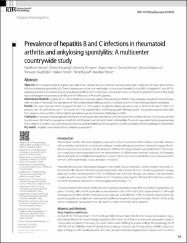Prevalence of hepatitis B and C infections in rheumatoid arthritis and anklyosing spondylitis: A multicenter countrywide study

View/
Access
info:eu-repo/semantics/openAccessDate
2014Author
Yılmaz, NeslihanKaradağ, Ömer
Gezmiş, Kimyon
Yazıcı, Ayten
Yılmaz, Sema
Kalyoncu, Umut
Tözün, Nurdan
Metadata
Show full item recordCitation
Yilmaz N, Karadag O, Kimyon G, Yazici A, Yilmaz S, Kalyoncu U, Kasifoglu T, Temiz H, Baysal B, Tozun N. Prevalence of hepatitis B and C infections in rheumatoid arthritis and anklyosing spondylitis: A multicenter countrywide study. European Journal of Rheumatology. 2014; 1: 51-54 doi: 10.5152/eurjrheumatol.2014.018.Abstract
Objective: Immunosuppressive therapies, especially tumor necrosis factor-α inhibitors, are frequently used in treatment of rheumatoid arthritis
(RA) and ankylosing spondylitis (AS). These therapies can induce viral reactivation in concurrent hepatitis B virus (HBV)- or hepatitis C virus (HCV)-
positive patients. On the other hand, the prevalence of HBV and HCV infections is not exactly known in RA and AS patients. The aim of this study
was to investigate the prevalence of HBV and HCV infections in RA and AS patients.
Material and Methods: A group of 1517 RA and 886 AS consecutive patients followed by six different rheumatology outpatient clinics of Turkey
were recruited in this study. The prevalence of HBV surface antigen (HBsAg) and HCV antibody (anti-HCV) were retrospectively investigated.
Results: The mean age was 49.0±13.2 years in RA and 37.3±10.5 years in AS patients. HBsAg prevalence was 35 (2.3%) in RA and 27 (3%) in AS
patients. Anti-HCV prevalence was 17 (1.1%) and 10 (1.1%), respectively. In the RA group, both HBsAg and anti-HCV positive patients were older
than negative ones (p<0.05), and the highest prevalence was found in those 60-69 years (p<0.05).
Conclusion: In previous national data, the prevalence of HBsAg has been reported as 3.99% and shown to increase with age. In this study we have
found a lower HBV infection prevalence in both RA and AS patients according to Turkish national data. This result may explain by being younger age
of our patients. In another conclusion, lower prevalence could be related to, joint complaints may less consulted to Rheumatologist in HBV positive.
Key words: Hepatitis, rheumatoid arthritis, ankylosing spondylitis

















